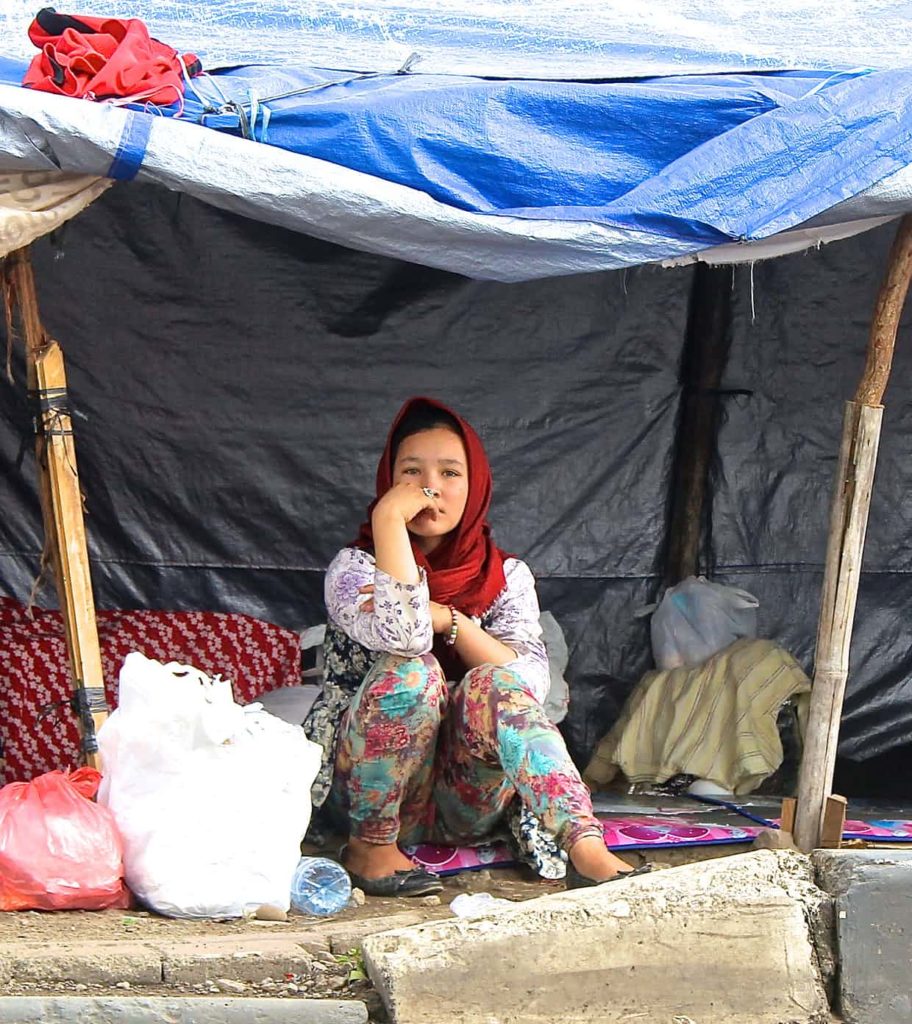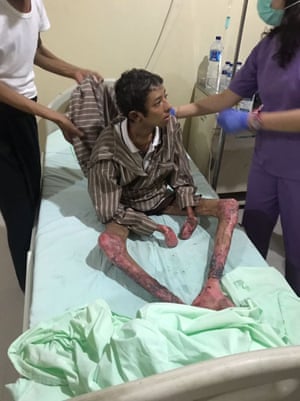Out of money and out of options, the families camped outside Indonesia’s Kalideres detention centre are feeling the pressure

Hazara asylum seeker Sharmila Attaie, 10, in a makeshift shelter outside the Kalideres immigration detention centre in Java. She lives on the street with her brother Farid and their family. Photograph: Kate Lamb
It has been 58 days.
That’s how long Farid Attaie has been sleeping on the footpath outside an immigration detention centre in Kalideres, West Jakarta, with his parents, five siblings, and another Hazara family of three.
Less than 20 metres from where they sleep the gates of the full-to-the-brim detention facility are topped with spirals of barbed wire designed to stop people from getting out.
But Farid and more than 300 homeless asylum seekers and refugees camped out on the street in makeshift tents of tarpaulin and bamboo are trying to do the opposite. They want to get in.
After years in limbo in Indonesia this is the end of the line – their money has run out and they have nowhere to go.
In the past asylum seekers would arrive in Indonesia from countries such as Afghanistan, Pakistan, Somalia and Iraq, hoping to board a boat to Australia.
But only a handful of boats have made it to Australian shores in the past three and a half years, and the few asylum seekers who have reached Australia have found themselves exiled – again – to languish indefinitely in Nauru and Papua New Guinea.
Refugees here are now hoping to be approved for third-country resettlement. But globally each year, less than 1% of refugees get that chance.
For the 13,885 asylum seekers and refugees in Indonesia, the walls have been steadily closing in.
In recent months the United Nations high commissioner for refugees has told them they are unlikely to ever be resettled.
“We don’t know for how many years we will be here,” says Farid, 20, as motorbikes and cars spray dust and fumes into his roadside shelter, “Last month UNHCR said never will you move to another country. And maybe you will be here for always.”
Farid’s family, apple farmers from Afghanistan’s Wardak province, fled their homeland after his eldest brother was shot dead by insurgents last year. After 10 months in Indonesia their money has gone.
“Never, or for 20 to 25 years, you will be here,” he continues, recalling the devastating news. “All people worry about this. They came here and told everyone.”
Exceptional cases – single mothers, single-parent families, unaccompanied minors or the physically and mentally impaired – will be given priority. For the rest, life in abeyance is taking its toll.
In detention centres in Java, Sumatra and Kalimantan there have been regular protests this year, while reports of depression and requests for psychological assistance are on the rise. A young Afghan asylum seeker committed suicide here last month, reportedly after hearing the news that resettlement would likely never come.
In Kalideres the desperation is palpable. The street is a string of horror stories.
“In the morning they come with guns – my family killed,”17-old-year-old Muhammad Al Amien from Darfur, in Sudan, says, mimicking the sound of gunfire. “I hid in the school.”
Living on the street that lines the detention centre, more than 300 asylum seekers and refugees are reliant on charity for water and food. To go to the bathroom and wash, they pay to use facilities at the local bus station.
Getting inside the centre would mean a roof over their heads and regular meals.
Outside, battling poor sanitation, crippling heat and monsoonal rain, people are getting sick.
Nursing his one-and-a-half-year-old son, a Hazara father, Salim Hussini, points to a fresh spray of scabies on the boy’s leg.
“My wife is sick and now my son is sick, he is hot and cold and now the rash,” he says, “But I finished my money – everything – so I have to come here.”
Hussain Badavi, a 22-year-old Iranian refugee who has been in Indonesia for five years – 20 months of which was spent in detention in Kalideres before he was moved into community housing – visits the area every few days to check on the asylum seekers’ health.

With the support of an Indonesian philanthropist, Badavi assists those needing medical treatment.
This past month he has helped asylum seekers suffering appendicitis, diabetes, tuberculosis and influenza, and intervened in the extreme case of Abdul Fatah, a young Yemeni man with a rare genetic skin disease called epidermolysis bullosa. The emaciated 21-year-old was found on the streets with blisters, scabs and lesions covering his body.
“I was shocked that with his condition he was staying outside on the street,” Hussain says. “That same day we took him to the hospital because it really was an emergency.”
In recent weeks things have gone from bad to worse.
The Australian Department for Immigration and Border Protection, part of the new home affairs department, has pulled funding to the International Organisation for Migration to support any new arrivals in Indonesia.
The DIBP is the IOM’s principal funder in Indonesia – on 2016 figures US$40m of the organisation US$49m in costs in the country were funded by Australia – so Canberra’s diktat means the organisation can no longer support any new asylum seekers, despite their continuing arrival.
“In an attempt to stem the flow of these new irregular migrants to Indonesia, IOM’s Australian Government donor (DIBP) has decided, as of 15 March 2018, to cease the previous automatic funding to support any new migrants who were not part of the organisation’s caseload effective that date,” IOM confirmed in a statement.
The number of new arrivals is declining but it hasn’t stopped. Last week five ethnic Rohingya from Myanmar who were stranded at sea for almost three weeks were rescued by fishermen in Banda Aceh.
The Guardian understands that at least 288 asylum seekers and refugees now camped outside the Kalideres detention centre will – at some point – be eligible for IOM assistance. But any new cases will not.
For this financial year the Australian government has earmarked A$52.6m to “support regional partners to manage asylum seeker populations in their countries”.
The bulk of this money goes to the IOM, which Australia funds to run programs including in Indonesian government immigration detention centres across the archipelago.
Between 2001 and 2016 Australia provided it with US$238m for Indonesian projects. And 95% of Australia’s total operation funding of IOM Indonesia was allocated to border control and irregular migration projects.
“In an attempt to stop refugees leaving Indonesia for Australia, Australia has outsourced a range of border control policies to IOM and the Indonesian government,” Asher Hirsch, senior policy officer with the Refugee Council of Australia, told the Guardian.
“Australia knows that once refugees reach its territory it has an obligation under international law to protect them. To avoid its legal obligations, Australia has spent significant resources to keep refugees remaining in countries of first asylum, where they have few rights, no secure future and, ultimately, no other option but to return home or seek safety elsewhere.”
A significant proportion of Australian money is spent encouraging people to abandon their claims to protection and return home. The IOM offers financial inducements – paid for by Australia – of A$2,000 for people to return to their home countries.
Between 2000 and 2016, 5,200 people were returned, according to the Australian embassy in Jakarta. The majority of those went to Afghanistan, Iran, and Pakistan, countries riven by conflict and political repression and that continue to produce significant refugee populations.
But the relationship between Australia and the IOM is opaque. A freedom of information request to reveal details of a government agreement signed with the IOM in 2000 was rejected by the Australian government, which argued: “The release of these documents would, or could reasonably be expected to cause damaged and significant harm to the bilateral relationship between Australia and Indonesia.
“The release of the information contained within the documents could diminish the trust placed in the department’s officials by the Indonesian government.”
Hirsch argues that knowing the details of Australia’s cooperation with Indonesia and the IOM is manifestly in the public interest.
“We know that where there is government secrecy, human rights abuses too often take place.”
A spokesman for Australia’s home affairs department offered few details about Australia’s program, confirming only that it funded the IOM to provide food, accommodation, medical assistance, interpreting services, counselling and assistance with voluntary returns. “The caseload now manages approximately 8,800 people.”
Refugee reality check
Even before Australia shut its borders, and the US president, Donald Trump, introduced tighter immigration policies, resettlement for refugees in Indonesia could take up to a decade. Now it looks like most could be stuck in Indonesia forever.
Alldo Fellix Januardy, a human rights lawyer at Suaka, an non-governmental organisation focused on refugee rights and protection, says it’s time the Indonesian government faced that new reality.
“The government should change its perspective on the refugee crisis, from temporary approaches and charity-based ones to more pragmatic ones,” he says.
Rather than spending money on detention centres to house refugees, Janurady argues, the government should consider the benefits they could bring to Indonesian society.
“Giving the right to education and to work for refugees in Indonesia is still sensitive due to xenophobia but if the government can think the other way, the government itself can gain economic benefit from that.”
Asylum seekers and refugees cannot legally work or study in Indonesia, although in some cases the IOM has negotiated for refugee children to attend local schools and for adults to attend vocational skills training.
A 2016 presidential decree gave refugees in Indonesia fundamental rights to shelter, food, clean water and healthcare.
But in many places, local governments are unaware the decree exists or they have resisted it. For many, those protections are non-existent.
Things aren’t good in Indonesia but those sleeping on the street in Kalideres still say it is better than the conditions they fled.
After two months on the streets outside the detention centre, Farid’s mother, Sakina, is worries what will become of her family but does not regret leaving Afghanistan.
“We made the best decision we could,” she says. “If we didn’t leave we would have been killed. There is no other way.”

